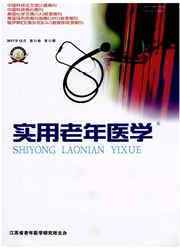

 中文摘要:
中文摘要:
目的:报道异基因造血干细胞移植治愈2例罕见8p11骨髓增殖综合征患者。方法:总结2例8p11骨髓增殖综合征患者的临床、实验室特征及接受异基因造血干细胞移植治疗过程。结果:病例1,双侧颈部淋巴结肿大伴白细胞异常升高,骨髓增生极度活跃,骨髓细胞遗传学示46, XY, (8;13)(p11;q12)。淋巴结组织病理检查结果为外周T细胞淋巴瘤,非特指型。病例2,多发浅表淋巴结肿大伴血常规异常就诊,血白细胞明显升高伴血小板减少,骨髓增生极度活跃,骨髓细胞遗传学示t(8;9)(p11;q32),分子生物学检测CEP110FGFR1融合基因阳性,淋巴结活检为T淋巴母细胞性淋巴瘤。2例患者均行人类白细胞抗原(human leukocyte antigen,HLA)相合同胞异基因造血干细胞移植治疗,无病存活分别为移植后16年和6年。结论:异基因造血干细胞移植是治愈8p11骨髓增殖综合征的有效治疗选择。
 英文摘要:
英文摘要:
To report 2 rare cases of 8p11 meyloproliferative syndrome cured by allogeneic hematopoietic stem cell transplantation. Methods: The clinical and laboratory features of 2 cases of 8p11 meyloproliferative syndrome were summarized, including the diagnosis and treatment process of allogeneic hematopoietic stem cell transplantation. Results: Patient 1 was presented with bilateral cervical lymphadenopathy and leukocytosis. The pathology of bone marrow showed extremely hyperplasia. The cytogenetic analysis showed a 46, XY, (8;13)(p11;q12) karyotype. The biopsy of the lymph node was peripheral T-cell lymphoma, unspecified. Patient 2 was presented with extensive lymphadenopathy with abnormal hemogram, which was leuekcytosis and thrombpenia. The bone marrow was hypercellular. The cytogenetic analysis on the bone marrow cells showed a translocation of t(8;9)(p11;q32). The CEP110-FGFR1 fusion transcript was detected by RT-PCR. The biopsy of the lymph node was T lymphoblastic lymphoma. These two patients received human leukocyte antigen (HLA)identical allogeneic hematopoietic stem cell transplantation, remained disease-free and survived 16 years and 6 years after transplantation, respectively. Conclusion: Allogeneic hematopoietic stem cell transplantation is the curative therapy for 8p11 meyloproliferative syndrome.
 同期刊论文项目
同期刊论文项目
 同项目期刊论文
同项目期刊论文
 The superiority of haploidentical related stem cell transplantation over chemotherapy alone as postr
The superiority of haploidentical related stem cell transplantation over chemotherapy alone as postr Immune reconstitution following unmanipulated HLA-mismatched/haploidentical transplantation compared
Immune reconstitution following unmanipulated HLA-mismatched/haploidentical transplantation compared Prevention of relapse using granulocyte CSF-primed PBPCs following HLA-mismatched/haploidentical, T-
Prevention of relapse using granulocyte CSF-primed PBPCs following HLA-mismatched/haploidentical, T- 期刊信息
期刊信息
